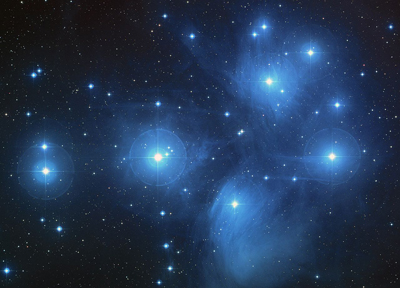There has been a debate about the distance to the Pleiades cluster that has been going for decades. Although it appears to have been resolved, well this is the claim of a team of radio astronomers in the US, who concluded that the cluster is approximately as far away as originally estimated. This contradicts analyses made form data from the Hipparcos, which suggested that the cluster is 13 parsecs closer than astronomical models predict.
The Pleiades is the star cluster most obvious to the naked eye in the night sky, and has been known since antiquity. In modern astronomy. It often appears low in the horizon in the Southern hemisphere. The distance to the Pleiades is used to calibrate the cosmic-distance ladder, allowing astronomers to calculate distances to other star clusters and galaxies that are further away. And so, it is important to know the distance to Pleiades precisely, and multiple calculations of it have been made using various methods by various researchers over the decades.
Currently the generally accepted distance was about 134 parsecs (about 437 light-years). Yet in 1999, Floor van Leeuwen of the Institute of Astronomy in Cambridge, UK, used data from the European Space Agency’s Hipparcos satellite to produce what was the most precise calculation to date. This estimate was obtained using trigonometric parallax. Van Leeuven arrived at a distance of about 120 parsecs, and in 2009 he refined his analysis but reached a similar conclusion.
In new research by Carl Melis of the University of California, San Diego and colleagues at several other US institutions, they did their own trigonometric-parallax measurement of five selected stars in the Pleiades cluster using very long baseline radio interferometry. In this technique, measurements are made by linked radio antennas spread across the world, giving the total resolution of a telescope the size of the Earth. The researchers found that the distances of all five stars were in broad agreement with the original figure, with the lowest value being 134.8 parsecs and the highest being 138.4.
However in 2013 ESA launched Gaia, a successor to Hipparcos with much higher specifications, such as higher-sensitivity cameras, that will measure the parallaxes of thousands of stars in the Pleiades cluster. The design principles are conceptually similar, which leads Melis and colleagues to suggest that the unidentified error they believe distorted the Hipparcos measurements of the Pleiades could also affect Gaia. Nevertheless, Melis suspects that “the Gaia measurement is not going to be the same as the Hipparcos measurement. Hopefully then the Hipparcos community is going to have to face the fact that Hipparcos did not produce the correct result.”
See the paper at Science:Â http://www.sciencemag.org/content/345/6200/1029
